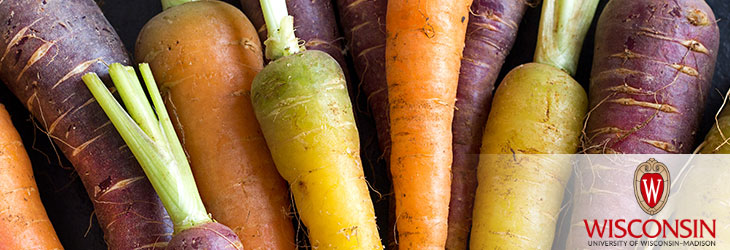Animals, Agriculture & Food

Making Large Quantities of Health-Promoting Thiosulfinates
WARF: P09143US02
Inventors: Kirk Parkin, Guodong Zhang
The Wisconsin Alumni Research Foundation (WARF) is seeking commercial partners interested in developing a simple and quick process for making large amounts of thiosulfinates and derivatives, which could serve as food ingredients or supplements to deliver health-promoting benefits from vegetables like onion and garlic.
Overview
Many of the documented health-promoting properties of Allium vegetables such as onion, garlic or chive have been ascribed to the organosulfur compounds unique to these species. These organosulfur compounds, which include thiosulfinates and sulfides, are readily absorbed and metabolized by the human body.
In contrast to garlic, when onion tissues are disrupted by chopping or grating, the majority of the onion sulfoxides are transformed into the volatile irritant lachrymatory factor (LF) instead of health-promoting thiosulfinates. An onion enzyme called LF synthase is responsible for this process, which reduces the health-promoting potential of onion. Researchers have tried to increase synthesis of thiosulfinates by knocking out LF synthase; however, there are several commercially available varieties of onions and it would be difficult to convert many of them to transgenic strains with silenced LF synthase genes.
In contrast to garlic, when onion tissues are disrupted by chopping or grating, the majority of the onion sulfoxides are transformed into the volatile irritant lachrymatory factor (LF) instead of health-promoting thiosulfinates. An onion enzyme called LF synthase is responsible for this process, which reduces the health-promoting potential of onion. Researchers have tried to increase synthesis of thiosulfinates by knocking out LF synthase; however, there are several commercially available varieties of onions and it would be difficult to convert many of them to transgenic strains with silenced LF synthase genes.
The Invention
UW–Madison researchers have developed a simple and quick way of making large amounts of thiosulfinates and desirable conjugates. They heated onions to inactive the enzymes, particularly LF synthase. The precursor sulfoxide compounds in the heated onion, which were not destroyed by this process, were added to a small portion of macerated garlic. The garlic extracts were washed to remove the native garlic organosulfur compounds, leaving a mixture of garlic enzymes and sulfoxide precursors from onions. This mixture produces thiosulfinates, rather than LF, from the onion. The thiosulfinates then can be extracted from the garlic-onion mixture.
This method results in high yields of thiosulfinates with high purity. Traditional organic synthesis approaches would require chromatography purification and the use of toxic and dangerous chemicals to achieve such high yields and purity. The thiosulfinate mixture then can be combined with thiols in water to easily yield mixed disulfide conjugates, which are odorless and maintain biological activities of the thiosulfinates.
This method results in high yields of thiosulfinates with high purity. Traditional organic synthesis approaches would require chromatography purification and the use of toxic and dangerous chemicals to achieve such high yields and purity. The thiosulfinate mixture then can be combined with thiols in water to easily yield mixed disulfide conjugates, which are odorless and maintain biological activities of the thiosulfinates.
Applications
- Production of thiosulfinates and conjugates that can be used to create nutraceutically-enhanced foods and beverages
Key Benefits
- Provides a simple and quick process for making large amounts of thiosulfinates and conjugates that are difficult to synthesize
- Enables the generation of odorless conjugates within 24 hours
- Utilizes onion wastes as well as wastes from virtually any other Allium vegetable
- Extracted thiosulfinates and conjugates have several health benefits, including anticancer, anti-inflammatory and antioxidant activities.
Additional Information
For More Information About the Inventors
For current licensing status, please contact Emily Bauer at [javascript protected email address] or 608-960-9842